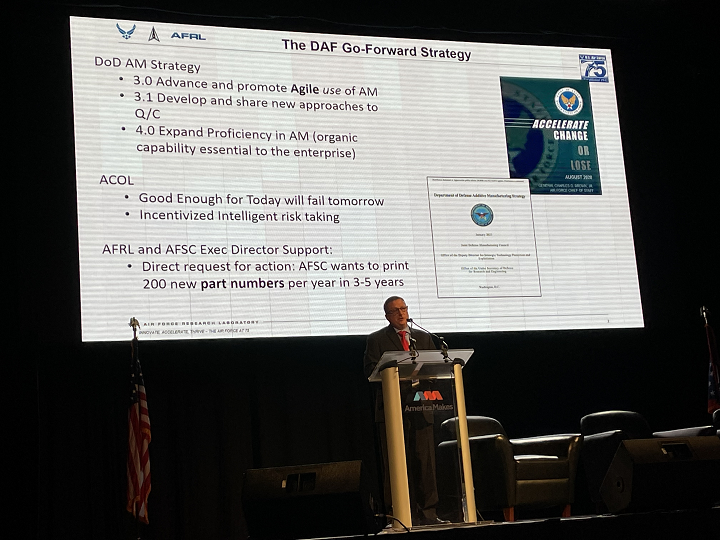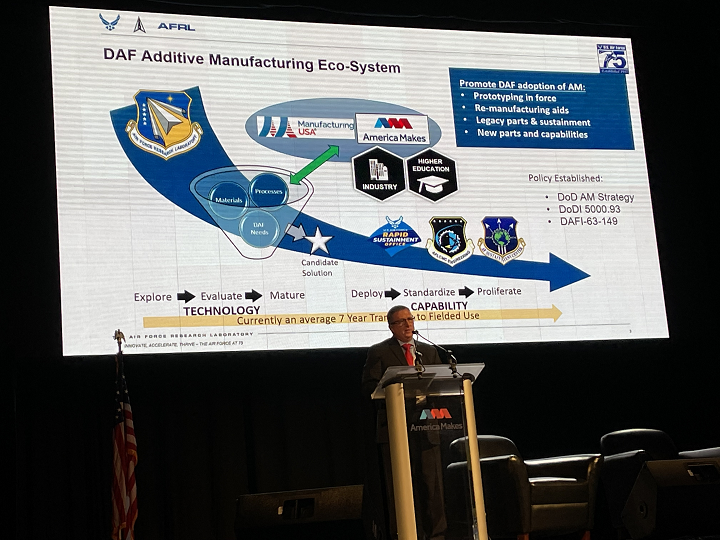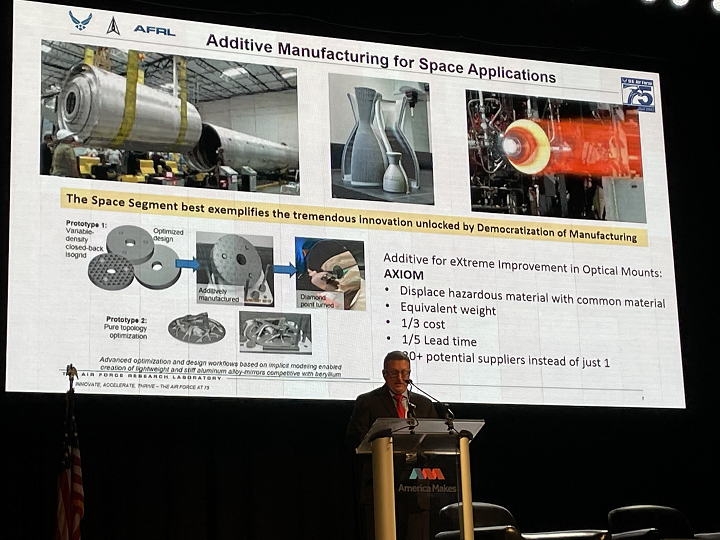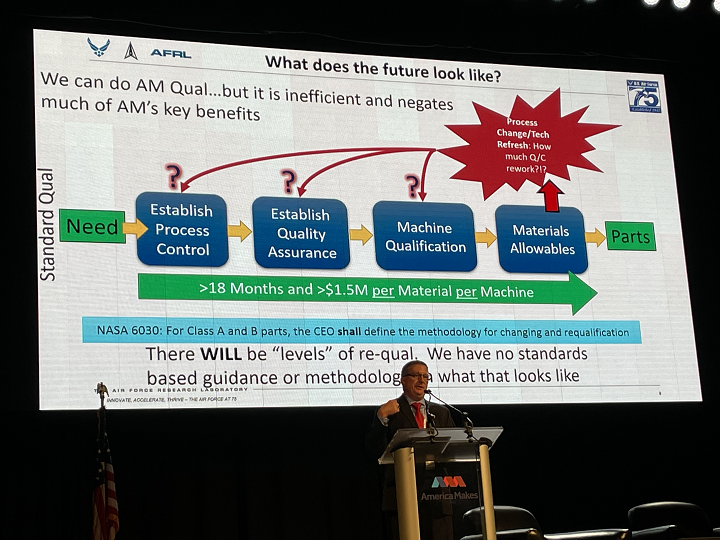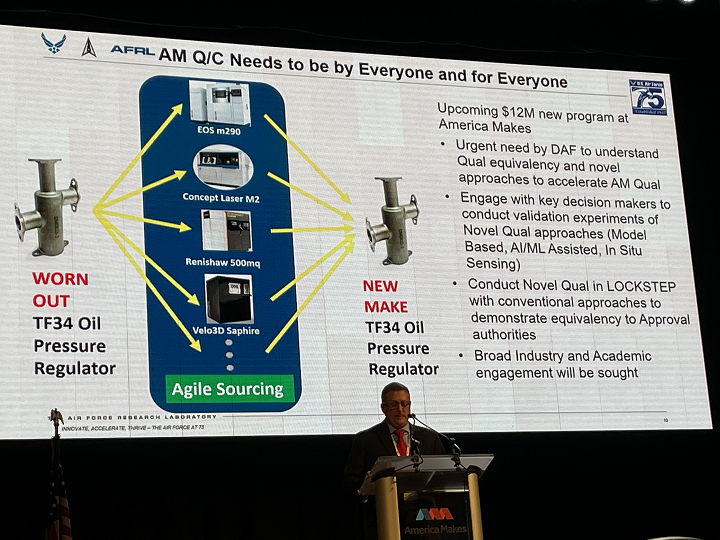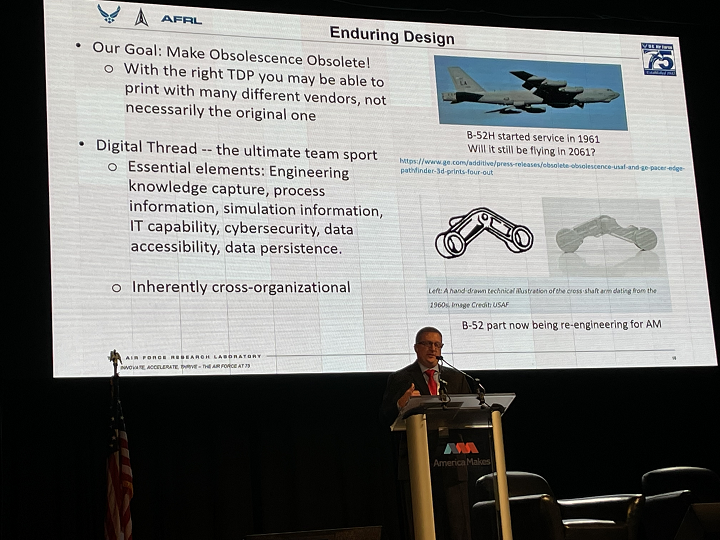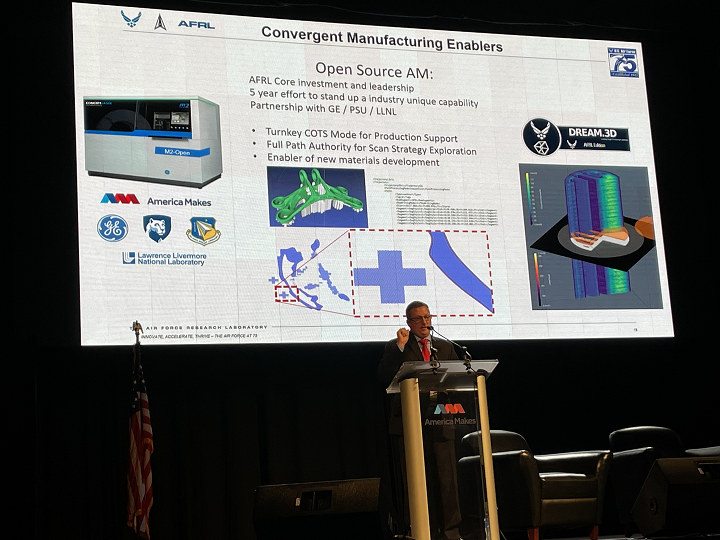America Makes is the United States’ leading public-private partnership for additive manufacturing (AM) technology and education, working to not only accelerate adoption of the technology in the country, but also to increase our manufacturing competitiveness through training, standards publication, projects, and more. The organization, which was the first of the Manufacturing USA Advanced Manufacturing Institutes, opened its doors in Youngstown, Ohio in 2012, and 3DPrint.com was on hand to celebrate its fifth birthday in 2017. So, of course, I made the nearly four-hour drive from my home in Dayton to help celebrate its 10th anniversary at MMX 2022, the Members Meeting and Exchange event for the more than 230 members of America Makes.
In the last article relaying my attendance of MMX 2022, I discussed a presentation by Dr. Susan Helper, the Senior Economist on the White House Council of Economic Advisors, followed by a panel on scaling AM for global supply chains. The day continued with a presentation by Colonel Charles D. Ormsby, the acting director of the Air Force Research Laboratory’s (AFRL) Materials and Manufacturing Directorate, who lectured on the use of AM by the U.S. Air Force in a talk titled “Additive Manufacturing in the U.S. Air Force – Perspectives and Opportunities.”
Speeding up Air Force Production with 3D Printing
In order to accelerate the use of AM for the Air Force and Space Force so they have the necessary capabilities when and where they’re needed, he said the AFRL was given a challenge: come up with 200 new 3D printed part families per year in 3-5 years, “which will be a huge leap in capability.”
Col. Ormsby explained that AFRL typically takes seven years from the time a part need is identified until there is “proliferated capability to manufacture and deploy that qualified part,” which won’t cut it for meeting this goal. He said that changing how qualification and certification are done will be a big help in getting where they need to be. But, it still won’t be enough.
“These are point solutions for our specific problems, but what about getting to where we can design for additive and advanced manufacturing? That’s when we will really unlock the value proposition,” he said.
He explained that there are three important things that make AM different, and why the Air Force wants to use it, and the first is its ability to democratize additive manufacturing; with this, qualification and certification will be problems we all need to help solve, from the military to small- and medium-sized manufacturers.
Democratizing Manufacturing with 3D Printing
The goal is organic DAF manufacturing, so bringing the end user—in this case the warfighter—who knows what they need, when they need it, into the production process is important. Col. Ormsby also explained that digital natives are the kids currently in school using 3D printing, who will naturally think more in terms of digital design, and that we need to figure out how to use this mindset to “change the state of the possible.”
Col. Ormsby says that democratizing manufacturing is especially taking off in the space community right now, and mentioned the AXIOM project, which stands for Additive for eXtreme Improvement in Optical Mounts. AFRL and America Makes are pushing for more democratized manufacturing on this project, and Raytheon, which received the Project Call funding for this project, is partnering with small businesses to print these optical mounts at 1/3 the cost and 1/5 the lead time. Another example is the Pacer Edge program with GE Aviation, first taking AFRL’s requirements to GE and letting them figure out the best way to print parts without long lead times.
“But during this process, we’re evolving to educate our people so we can take over and design and build, organically, to address our needs at the point and time of need,” he said.
Improving AM for the Air Force
Currently, qualification and certification of 3D printed parts is inefficient, and negates many of the key benefits of additive. So what does the future look like?
“Our response is the program we intend to announce at TRX in October of this year, but I suppose I just announced it now,” Col. Ormsby said.
The new $12 million additive manufacturing qualification program will take a part that’s been certified as a drop-in replacement, with one powder, process, and machine, and explore how to complete DELTA qualifications for the part.
In bringing production to the warfighter, Col. Ormsby explained that AFRL received the authority to run the SBIR Strategic Finance Increase Program about three years ago, which allows them to invest more money in SBIR programs and “unlock cost-sharing from government and private partners.” Within the directorate, AFRL partnered with the Rapid Sustainment Office in the Life Cycle Management Center to invest $14 million to stand up a program aimed at putting additive capability at the point of need. Its investment unlocked another $14 million in funding from AFWERX, while partner Essentium brought in its own cost share, and the program resulted in 3D printers being deployed to the National Guard and others.
“Our next generation was born digital, they get this stuff,” he said. “Today, when you look at the gray-haired folks like me, we were working on subtractive manufacturing, like machining, and we’re not embracing the full potential that additive technology provides. So when will we begin taking advantage?”
Col. Ormsby said that there’s a lack of integration between design and manufacturing, and that true closed-loop systems are still mainly research at this point.
The final point that makes AM a different and necessary technology for AFRL, and the entire Air Force, is trying to change the state of the possible by making obsolescence obsolete. Col. Ormsby explained that convergent manufacturing is what we need to aim for now, the “idea of designing for what we need, using multiple materials, controlling print processes to print functionality into the systems we’re manufacturing, and designing the functionality and a single manufacturing process around it.”
AFRL is working towards hiring a senior scientist to bring together a portfolio of work that can address the long-term needs of the aerospace industry, and advanced manufacturing in general, and Col. Ormsby predicts that America Makes will be very involved at this level. In order to achieve the goal of 200 new 3D printed part families per year in 3-5 years, the AFRL needs to truly understand the AM processes it will be using, and has adopted a Concept Laser M2 system for this purpose.
The next panel, which I will discuss in an upcoming article, gave audience members an opportunity to get into the nitty gritty about America Makes, its strategy, and 3D printing overall. Stay tuned!
Subscribe to Our Email Newsletter
Stay up-to-date on all the latest news from the 3D printing industry and receive information and offers from third party vendors.
Print Services
Upload your 3D Models and get them printed quickly and efficiently.
You May Also Like
3D Printing News Briefs, July 2, 2025: Copper Alloys, Defense Manufacturing, & More
We’re starting off with metals in today’s 3D Printing News Briefs, as Farsoon has unveiled a large-scale AM solution for copper alloys, and Meltio used its wire-laser metal solution to...
3DPOD 260: John Hart on VulcanForms, MIT, Desktop Metal and More
John Hart is a Professor at MIT; he´s also the director of the Laboratory for Manufacturing and Productivity as well as the director of the Center for Advanced Production Technologies....
3D Printing News Briefs, June 28, 2025: Defense Accelerator, Surgical Models, & More
In this weekend’s 3D Printing News Briefs, 3YOURMIND was selected to join an EU Defense Accelerator, and PTC has announced model-based definition (MBD) capabilities within Onshape. Finally, a study out...
EOS in India: AM’s Rising Star
EOS is doubling down on India. With a growing base of aerospace startups, new government policies, and a massive engineering workforce, India is quickly becoming one of the most important...


